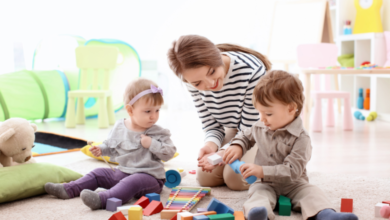A Comprehensive Handbook on Parenting Your Child in Their Initial Week of Preschool

Brief Overview
The first week of preschool is a significant milestone for both children and parents. It marks the beginning of a new chapter filled with excitement, challenges, and growth. As children adjust to their new environment, parents play a crucial role in supporting and guiding them through this transition. This comprehensive guide offers detailed advice on how to navigate your child’s first week of preschool, from preparation to managing separation anxiety and fostering a positive experience.
Introduction
Starting preschool is a big step for young children and their families. It introduces them to a structured environment outside of the home, where they will interact with peers, learn new skills, and develop independence. For many children, this transition can be both thrilling and anxiety-provoking. Parents can play a pivotal role in easing their child into this new experience. This article provides practical tips and strategies to help parents support their child during their first week of preschool, ensuring a smooth and positive start.
1. Preparing Your Child for Preschool
- Discuss the Transition: Begin talking to your child about preschool well before their first day. Use simple language to explain what preschool is, what they will do there, and who will be taking care of them. Highlight the exciting aspects, such as making new friends and learning new things.
- Visit the Preschool: If possible, visit the preschool with your child before their first day. Familiarize them with the environment, including the classroom, playground, and any other areas they will use. Meeting the teacher and other staff can also help reduce anxiety.
- Establish a Routine: Begin establishing a routine that mirrors the preschool schedule. Adjust bedtime and wake-up times to align with the preschool’s schedule, so your child’s transition to a new routine is smoother.
- Read Books About Preschool: Share books and stories about starting preschool to help your child understand what to expect. These stories often provide relatable scenarios and reassure children about the new experience.
2. Managing Separation Anxiety
- Create a Goodbye Ritual: Develop a consistent and reassuring goodbye ritual to help ease separation anxiety. This could be a special hug, a secret handshake, or a phrase you say every day. Consistency helps children feel secure and know what to expect.
- Be Calm and Positive: Children often pick up on their parents’ emotions. Stay calm and positive during drop-off to help your child feel more at ease. Avoid prolonging goodbyes, as this can increase anxiety and make the separation more difficult.
- Provide Comfort Items: Allow your child to bring a comfort item from home, such as a small stuffed animal or family photo. These items can provide reassurance and comfort during the day.
- Gradual Transitions: If possible, start with shorter days or partial attendance to help your child gradually adjust to the new environment. Gradually increase the time they spend at preschool as they become more comfortable.
3. Supporting Your Child During the First Week
- Stay Engaged: Communicate regularly with your child’s teacher to stay informed about their progress and any challenges they may be facing. This helps you stay connected with your child’s experience and address any concerns promptly.
- Encourage Independence: Foster your child’s independence by encouraging them to take part in self-care activities, such as dressing themselves and managing their personal belongings. This builds confidence and prepares them for the preschool environment.
- Reinforce Positive Behavior: Praise and reinforce positive behavior and efforts your child makes during their first week. Positive reinforcement helps build their confidence and encourages them to embrace the new experience.
- Discuss the Day: Ask open-ended questions about their day, such as “What was your favorite part of today?” or “What did you do with your friends?” This encourages your child to share their experiences and helps you understand how they are adjusting.
4. Dealing with Common Challenges
- Handle Tears and Worries: If your child is upset or expresses concerns about going to preschool, acknowledge their feelings and offer reassurance. Listen to their worries and validate their emotions, while providing comfort and encouragement.
- Address Behavioral Changes: Monitor any behavioral changes that may occur during the transition, such as changes in sleep patterns or increased clinginess. Address these changes with empathy and patience, and communicate with your child’s teacher for additional support if needed.
- Avoid Over-Scheduling: Avoid over-scheduling activities outside of preschool during the first week. Allow your child time to adjust and relax at home, and provide opportunities for rest and play.
5. Fostering a Positive Experience
- Celebrate Small Achievements: Celebrate small achievements and milestones, such as completing their first day or making a new friend. Positive reinforcement helps build enthusiasm and confidence.
- Create a Positive Home Environment: Maintain a positive and supportive home environment. Reinforce that preschool is a fun and exciting place where they will learn and grow.
- Stay Flexible: Be flexible and adaptable to your child’s needs. Each child adjusts to preschool at their own pace, and it’s important to be patient and supportive during this period of transition.
- Encourage Socialization: Encourage playdates and social interactions with other children from preschool to help your child build friendships and feel more comfortable in their new social environment.
6. Long-Term Strategies for Success
- Maintain Open Communication: Continue to communicate with your child’s teacher and preschool staff throughout the school year. Regular updates and feedback can help you stay informed about your child’s progress and address any concerns.
- Reinforce School Routines: Reinforce the routines and expectations established at preschool at home. Consistent routines help children feel secure and help them transition smoothly between school and home.
- Promote Positive Attitudes: Encourage a positive attitude towards learning and school by showing interest in their activities and expressing enthusiasm about their experiences. A positive attitude towards school helps foster a love of learning and reduces anxiety.
Conclusion
The first week of preschool is a significant milestone that can be both exciting and challenging for children and parents alike. By preparing your child for the transition, managing separation anxiety, supporting them through the initial adjustment period, and fostering a positive experience, you can help ensure a smooth start to their preschool journey. Remember that patience, consistency, and open communication are key to helping your child adapt to their new environment and enjoy their time at preschool. With your support and encouragement, your child can navigate this new chapter with confidence and enthusiasm.




